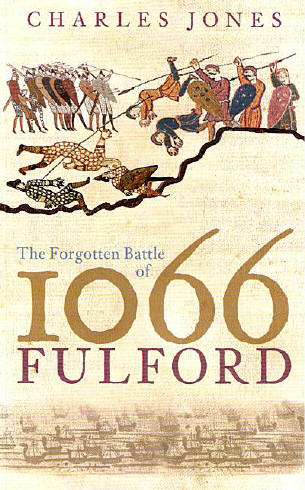
Well illustrated plus timelines, glossary and maps.
Contact me and I will sell you a signed copy. Very special price of £12.85 including postage in Europe (Please add an extra $ for overseas delivery)
 |
The Forgotten Battle of 1066, Fulford by Charles Jones
Published by Tempus/The History Press July 2007
Well illustrated plus timelines, glossary and maps. Contact me and I will sell you a signed copy. Very special price of £12.85 including postage in Europe (Please add an extra $ for overseas delivery) |
Chapter one
The England of king Harold Godwinson
Chapter two
King Harald of Norway Ė The victor of the battle at Fulford
Chapter three
Defence of the kingdom in 1066
Chapter four
Earl Tostig - The choreographer of Englandís demise
Chapter five
Preparing for battle
Chapter six
The battle at the ford on 20 September 1066
Chapter seven
Postscript - The events at Fulford had consequences
Foreword to the book
I have attempted to tell a remarkable story of some impressive people. As
fiction, an editor would demand the plot was simplified and made more credible.
Hollywood simply could not cope with such a cast of characters or unlikely
sequence of events.
Two young warriors, grandsons of the remarkable lady Godiva, faced not only the
greatest warrior of the age but also his ally, earl Tostig. Tostig was none
other than the brother of the recently selected, one could almost say elected,
king Harold II of England. Tostig had been ousted in a coup the year before by
those he faced at Fulford.
Tostigís plots and plans posed a strategic problems for England. His marriage
had made him William of Normandyís kin. But those he faced were also his
brothers-in-law. They would soon be uncle to the heirs of the throne when Edwin
and Morcarís sister produced twins to king Harold.
Sadly this is not Hollywood and there is an unhappy ending for all these good
people. I do however, try to end on a happy note in the closing words of the
book.
I am very grateful to the many friends in York who have supported me in this
enterprise and encouraged me to write this book. Special thanks go to Val Parker
who has nor only got her hands dirty exploring the battle site but has
undertaken the editorial work for the book.
Could I encourage you to read the short section explaining how the literary
sources have been used and reconciled with the available physical evidence. The
battlefield is like a 1000 year old crime-scene investigation and I attempt to
explain how the gaps and inevitable conflicts in evidence have been handled.
One question the book does not address is why is so little attention paid to
this important battle of 1066. I hope this book will begin to redress this
neglect.
Chas Jones
Oxford 2005